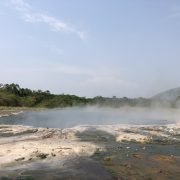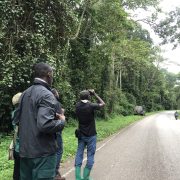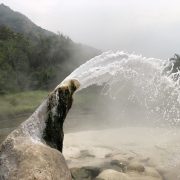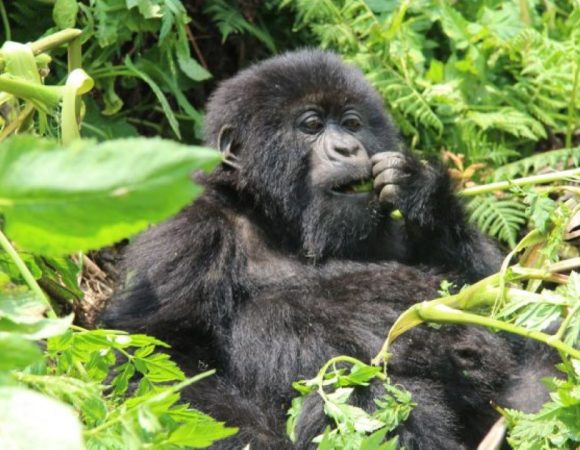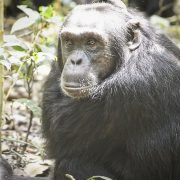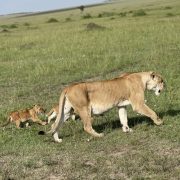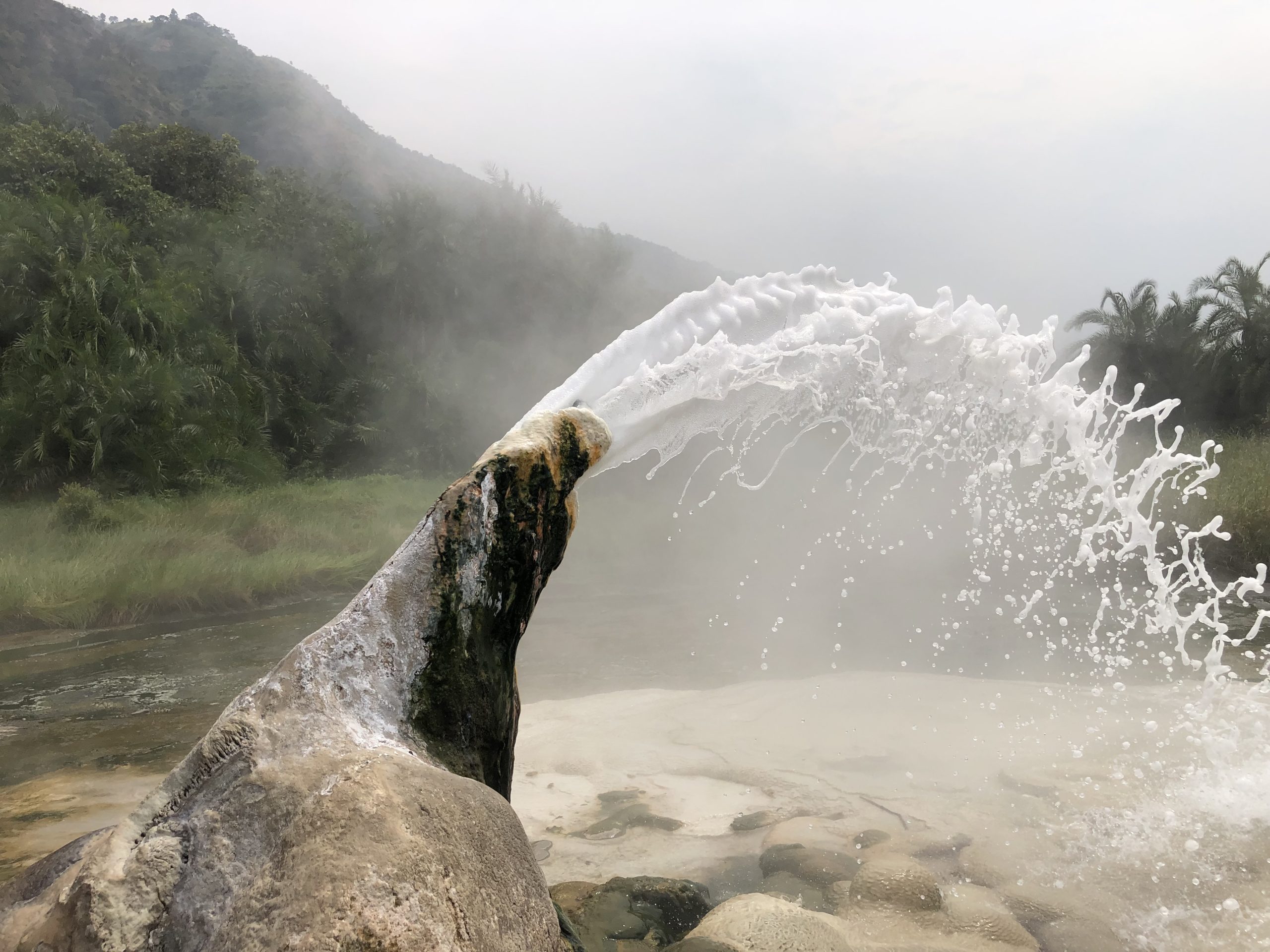
Semuliki National Park : Things to do in Semuliki National Park, Semuliki National Park Hot springs
Semuliki National Park is truly one of Uganda’s most iconic national parks, rich in bio-diversity and a bird watcher’s paradise. The national park is less visited compared to other parks in Uganda, this, makes one’s experience in Semuliki National Park even more appealing as you will encounter less crowds. Semuliki National Park is known for bird watching and is one of the top birding sites in Uganda. This however does not mean that you can only do birding here, there is so much more to see and do from forest walks to waterfall hikes to hot springs among other activities.
The park is popularly known for the Sempaya Hot springs which are a unique attraction that takes you to the female and male hot springs inside the park. Situated in the western section of the East African Rift Valley, Semuliki’s bio-diversity is distinctive as its mainly made up of dense lowland tropical forest and situated within the Congo basin. The vegetation of Semuliki is a habitat for rare bird species and mammals, many of which are found nowhere else in East Africa. Coupled with its location within the Congo basin, Semuliki National Park offers a visitor a different experience from other parks while on a safari in Uganda.
Visitors usually choose to combine a visit to Semuliki National Park with the chimpanzee trekking adventure in Kibale National Park and a wildlife safari in Queen Elizabeth National Park. This arrangement makes sense because all these parks are located in the western circuit of Uganda hence transfers between the parks take a shorter time.
History of Semuliki National Park
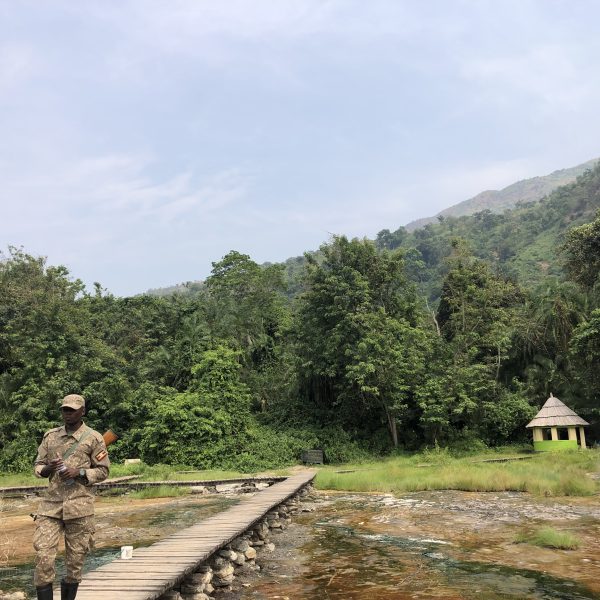
A wooden walk way and ranger guide in Semuliki National Park
Semuliki National Park covers an area of 220 square kilometers and is a protected area within Uganda’s Albertine rift at the border with DRC. The protected area lies within the borders of Bundibugyo district that is situated in western Uganda. Semuliki National Park was first gazetted as a forest reserve in 1932 and was at the time managed by the forest department. In 1992, the forest department raised its status to a forest park. It was officially and formally gazetted as a national park in 1993 and management was transferred to Uganda National Parks (UNP) which later changed to Uganda Wildlife Authority (UWA) in 1996. During the 70s to the early 80s, the park was encroached by the communities that lived close to the park as the governance at the time was lacking in areas of conservation. However from the late 80s to 90s, government decided to evict encroaches from protected areas and Semuliki National Park was allowed to regenerate with a lot of seed bank of both exotic and invasive species.
Vegetation of Semuliki National Park
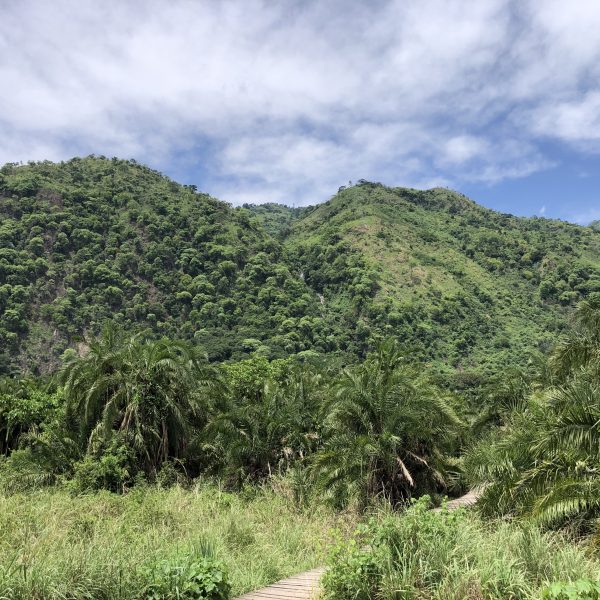
A glimpse in to the vegetation in Semuliki National Park
Semuliki National Park is classified as semi-deciduous forest and is the only true low land tropical forest in Uganda and among the few in East Africa. Most of the forest is dominated by cynometra alexandrii (iron wood) but the edges of the park are varied with riverine swampy forest along the Semuliki River and savanna grassland to the North-East. Semuliki National Park has 336 tree species that have been recorded, 24 species are restricted and 3 species are considered endangered. The park also has flowering plants,the flowering plants recorded at Semuliki National Park represent 7.4% of Uganda’s total, 7 species of these are endemic to the Albertine Rift region.
Wildlife in Semuliki National Park
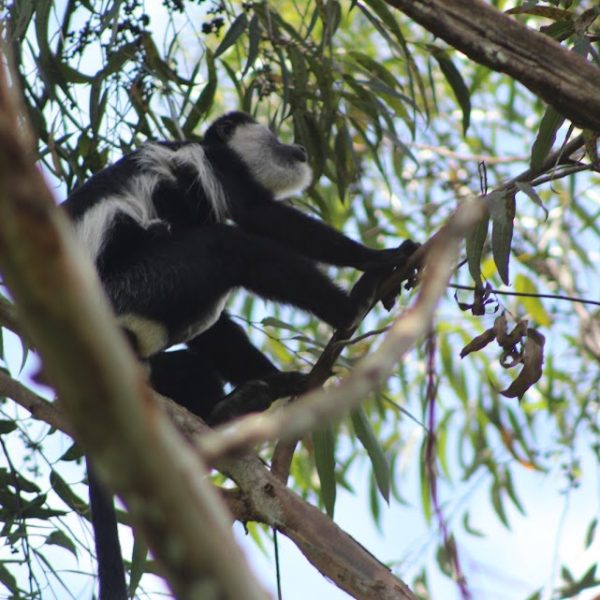
A Black-and-white Colobus Monkey
Semuliki National Park is home to about 60 mammal species making it a mammal rich destination. The park hosts 9 primate species that include Chimpanzees, Black-and-white colobus monkeys that are usually encountered while on nature walks in the park, Red-tailed monkeys, Red-cheeked Mangabey, De Brazza’s Monkey, Olive baboons, Vervet monkeys, Pottos and Bush babies. Some of these mammal species are mainly nocturnal. Large mammals in Semuliki National Park include African Elephant, Bush pig, Buffalo, Sitatunga, African Civet, Warthogs and White-bellied duiker. The African Elephants are rarely seen as they usually feed in the western section of the park and the North-Eastern section where there is savanna grassland vegetation.
11 species of mammals are only found in Semuliki National Park and nowhere else in Uganda which makes it a prime destination for mammal watching in Uganda. These include the Pygmy Flying Squirrel, Mona Monkey, Bay Duiker, Beercroft’s Flying Squirrel and six types of bat species.
Birds of Semuliki National Park
When it comes to bird watching, Semuliki is a must visit while birding Uganda as 441 species of birds have been recorded at the park including 35 Guinea-Congo forest biome bird species. Semuliki National Park is known as a bird watcher’s paradise as birding here is very rewarding. There are a number of birding trails in the park but the Kirumya trail is the most popular birding trail as it offers good chances of looking out for a variety of species. The 13km Kirumya trail starting point is a short drive away from the park headquarters and the trail takes you through the forest towards River Semuliki.
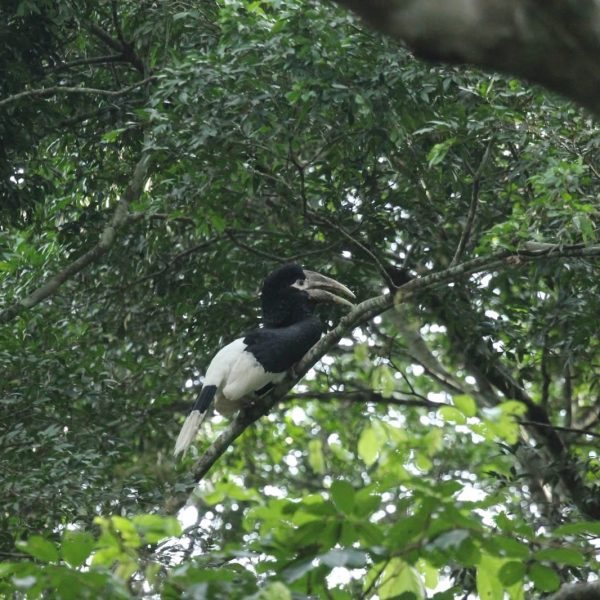
White-thighed Hornbill in Semuliki National Park. Photo by Turyashemererwa Alex
Semuliki National Park has 35 restricted-range birds that can only be found in the park and nowhere else in East Africa. These species include Congo Serpent Eagle, Black-throated Coucal, Grey-throated Rail, Red-billed Dwarf Hornbill, Black Dwarf Hornbill, Spot-breasted Ibis, Bates’s Nightjar, Red-bellied Malimbe, Grant’s Bluebill, Gabon Woodpecker, African Piculet,Yellow-throated Nicator, Blue-billed Malimbe, Fiery-breasted Bush-shrike,Red-eyed Puffback, Black-casqued Hornbill, Spotted Honeyguide, Maxwell’s Black Weaver, Long-tailed hawk and the White-crested Hornbill.
Other bird species to look out for while birding in the park include Papyrus gonolek, African Dwarf Kingfisher,Marsh Tchagra, Sacred Ibis, Forest Scrub Robin, Rufous-sided Broadbill, Zenker’s Honeyguide, Yellow-eyed Bristlebill, Blue-shouldered Robin-Chat, Capuchin Babbler, Lemon-bellied Crombec, Lowland Sooty Boubou, Red-chested Goshawk, Fraser’s Rufous Thrush, Piping Hornbill, Grey Ground Thrush, Brown-chested Alethe, Jameson’s Wattle eye, Capuchin Babbler, Yellow-footed Flycatcher, African Pied Hornbill, Blue-breasted Kingfisher, Palm-nut Vulture, Xavier’s Greenbull, Hartlaub’s Duck.
Things to do in Semuliki National Park
Visit Sempaya Hot springs
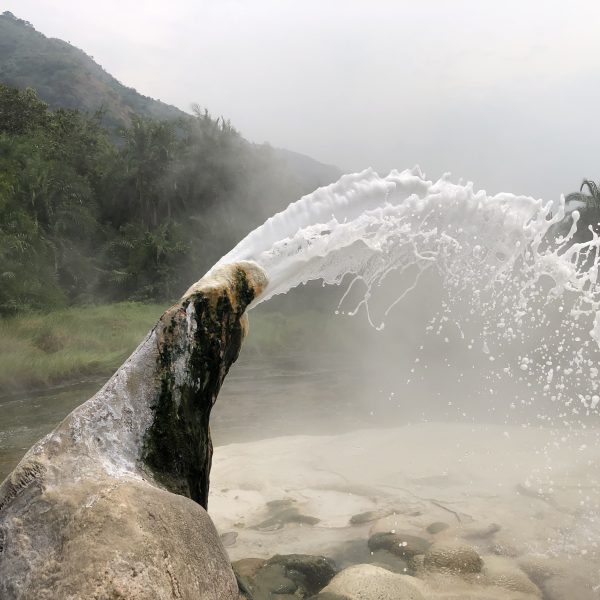
Female hot springs in Semuliki NP
The Sempaya Hot springs trail begins at Sempaya visitor centre and ends at the male hot springs. The hot springs are a short walk away from the reception area at Semuliki National Park and are a popular attraction at the park. The trail offers one an opportunity to visit and learn about the formation of Sempaya hot springs.
After briefing from your guide, you start the walk to the female hot springs, there are wooden walk ways that lead you to the area where you boil eggs and matooke for an experience of the hot boiling water that prepares food. You have an opportunity to participate in cooking the food with the guidance of your guide. The hot springs also offer you opportunity to take photos.
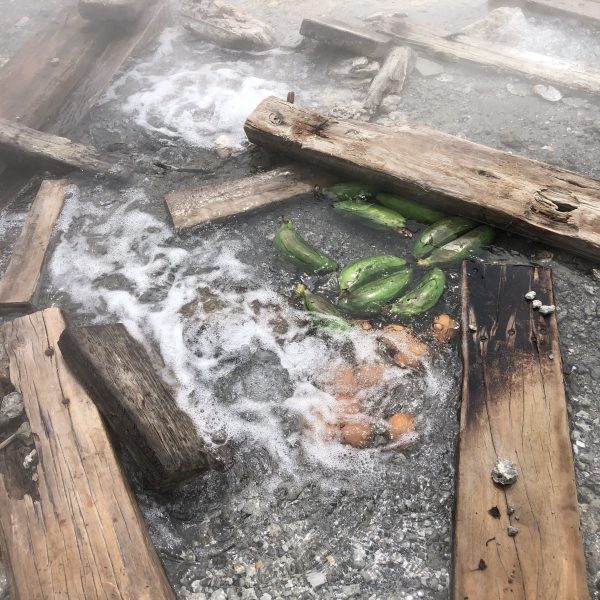
Eggs and matooke (green bananas) boiling at the hot springs
The female hot springs visit is followed by a visit to the male hot springs where you get to spend time learning more on the formation of the hot springs. Scientifically the hot springs were formed as a result of geothermal activity where underground water heated by hot rocks or magma rises to the ground through cracks however culturally the Bamaga clan which is a group of people that live in the communities that neighbor the park have a spiritual attachment to the hot springs. The Bamaga clan believe their male ancestors stay at Bitente (male hot spring) and the female ancestors stay at Nyansimbi (female hot spring). Every year the clan members visit the host springs to worship and appease their ancestors, while on the visit you will see one of their worshiping places near the male hot spring. The visit to the hot spring can take between 1 – 1.5 hours depending on your interests. The boiling temperatures at the male hot spring can go up to 103 degrees Celsius while the temperatures at the female hot spring can go up to 100 degrees Celsius, the temperatures at the male hot spring are hotter so you are advised to keep a distance while on the visit.
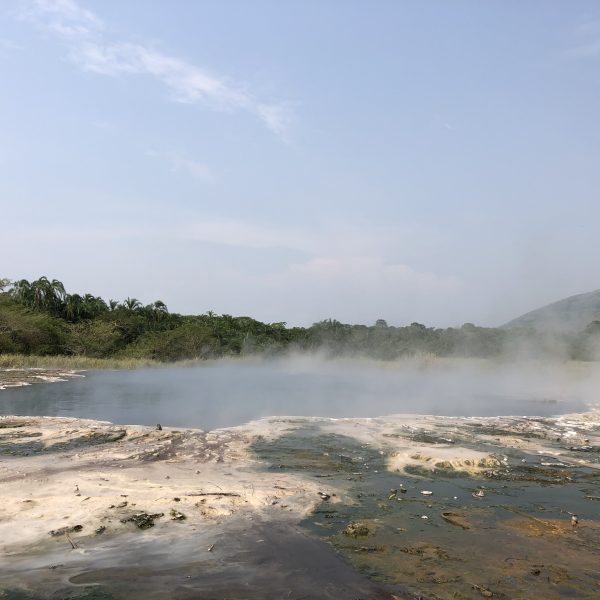
Male hot spring in Semuliki NP
Birding in Semuliki National Park
Semuliki is a bird watcher’s haven as 441 species of birds have been recorded here. The best trail for birding in Semuliki NP is the Kirumya trail however bird watching starts along the way, at the park headquarters, at the lodge where you can look out for sun birds and also at the geothermal hot springs where you look out for sand pipers, migrant bird species and stints that like to feed on the insects and other invertebrates that are attracted by the algae and aquatic plants near the hot springs. As mentioned above since Semuliki National Park has 35 restricted-range birds that can only be found in the park and nowhere else in East Africa, you have an opportunity to look out for them while on your birding safari to Semuliki. Semuliki is such a rewarding destination for birding, we highly recommend birding Semuliki while on a birding tour to Uganda.
Chimpanzee Trekking in Semuliki National Park
Semuliki is one of the conservation areas in Uganda where one can do chimpanzee tracking. The chimpanzee trek in Semuliki begins at the park headquarters where you meet the ranger guides, after a briefing from the ranger guides about the guide lines to follow while on the trek you then start the activity. Being a low land tropical forest, you can expect to walk through thick thickets and swamps so make sure to pack good hiking shoes. Once you locate the chimpanzees, you are allowed to spend one hour with them taking photos and watching them. The chimp trek can take between 4-6 hours depending on the location of the chimps that day and your physical fitness. Although Semuliki National Park offers a chance to trek the chimpanzees, the best place in Uganda to do chimpanzee trekking remains Kibale National Park. The chimpanzee trek at Kibale National Park offers higher chances of seeing the chimpanzees as the population of chimps at the park is estimated at 1,500. This means that the population in Kibale NP is higher than the one in Semuliki NP hence higher chance of encountering the chimpanzees while on the trek.
Boat ride on Lake Albert
One of the things to do while in Semuliki National Park is the boat ride on Lake Albert at Ntoroko. This boat ride activity is usually done by birders visiting Semuliki for birding, the boat ride on Lake Albert is one of the best places to look out for the elusive shoebill while birding in Uganda. The other place in Uganda to see the shoe bill is Mabamba wetland. The boat ride is on a motorized canoe and aside from the shoebill you have opportunity to look out for water birds and papyrus endemics. The boat ride is also a great way to enjoy a relax ride on Lake Albert, see fishing villages situated at the shores and you might also come along local fishermen on the lake as they go about their day fishing.
Nature walks in Semuliki National Park
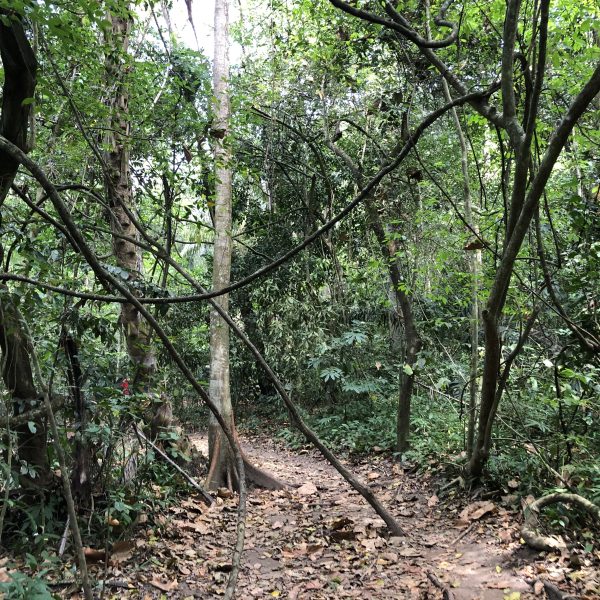
On one of the forest trails in Semuliki NP
For a nature lover, Semuliki National Park is the perfect place to visit. The walks will take you through the forest as you look out for trees, butterflies, plants and so much more. You also get to enjoy stunning escarpment views from the Sempaya hot spring trail while on your nature walks in the park. With nature walks, you get to walk through the different trails in the park as you also learn about the flora and fauna of Semuliki National Park. The walks are a great opportunity to look out for primates like the Red-tailed monkey, Black-and-white colobus monkey, vervet monkeys and olive baboons among others.
Mammal watching in Semuliki National Park
Semuliki National Park is known for mammal watching in Uganda and is usually combined with Kibale National Park while on a mammal watching safari. About 60 mammal species have been recorded at the park, of these species 11 are endemic and 27 are large mammals. The park offer one an opportunity to look out for the large mammals and other small animals. To have a rewarding mammal watching tour here, we highly recommend getting a knowledgeable guide for a rewarding experience. Mammals that you look out for while here include Bush babies, the Pygmy Flying Squirrel, De Brazza’s Monkey and bush pigs among others. You also look out for smaller mammals like the Target Rat, Yellow-winged Bats, Straw-coloured Fruit Bat and the Little Collared Fruit Bat. The park is hosts about 6 different bat species.
Best time to visit Semuliki National Park
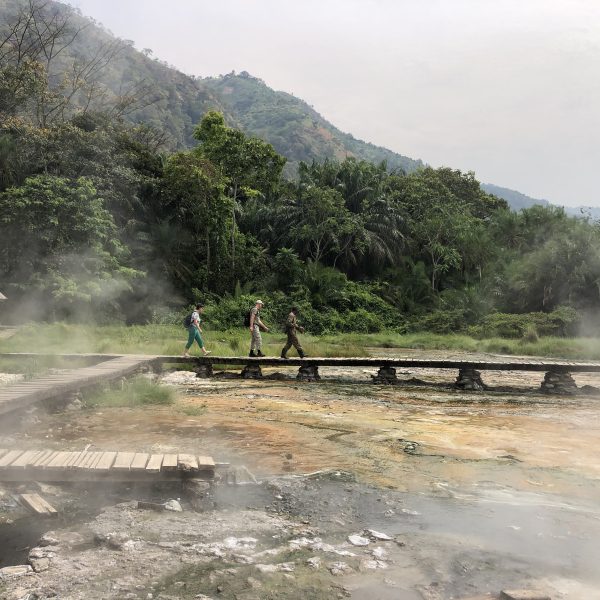
Visitors heading to the female hot springs
The park can be visited all year round and the park headquarters are open to visitors throughout the year however the dry months are the best time to visit Semuliki National Park. The dry season months run from June to September and from December – February. The nature trails are dry and easy to navigate during the dry months as opposed to the wet months when the trails can get muddy and slippery due to heavy rainfall. So if you plan to visit during the wet months, remember to pack a rain jacket and good hiking shoes. The wet months or rainy season is between October to November and March to May.
How to get to Semuliki National Park
Semuliki National Park can be accessed from Kampala, Fort Portal and through Mbarara, all these 3 are districts in Uganda. From Kampala by road, the journey takes you about 6 hours. The route is Kampala – Mubende – Kyenjojo – Fort Portal – Nyakasura – Kibuku town and then finally to the Sempaya visitor centre which is the main park headquarters for Semuliki NP. The distance from Kampala to Semuliki is 387kms.
From Fort Portal town, you branch off along the Nyakasura – Budibugyo road and the drive from the town to the park takes you about 2 hours.
If coming through Mbarara, the distance to Semuliki National Park is 465km and by road it takes you about 7 – 8 hours to arrive. The route used is Kampala – Masaka – Mbarara – Kasese highway – Semuliki NP. This route is longer but the advantage with it is that you can break the journey by stopping over in Lake Mburo National Park or Queen Elizabeth National Park.
You can also get to Semuliki National Park by air with a combination of road transport. You fly to Mweya Air strip in Queen Elizabeth National Park from Entebbe International Airport. On arrival at Mweya, your driver guide then transfers you to Semuliki National Park by road (4 hours).
Accommodation in Semuliki National Park
Accommodation facilities near Semuliki National Park are few since the park was previously less visited, below are some of the lodges to stay at;
Semuliki Safari Lodge – this is the best safari lodge option in the park at the moment. The lodge is a luxury facility located in the Toro-Semuliki wildlife reserve and features thatched cottages with a touch of African interior décor. The safari lodge has excellent staff, a dining area serving delicious meals and can only accommodate 18 guests at a time.
Ntoroko Game Lodge – Ntoroko game lodge is a mid-range facility situated in the Semuliki game reserve that has 5 comfortable tents for guests with stunning views of the Rwenzori Mountain ranges. All the tents are en-suite and feature comfortable wooden beds made by locally sourced materials, clean linen and mosquito nets for each tent.

